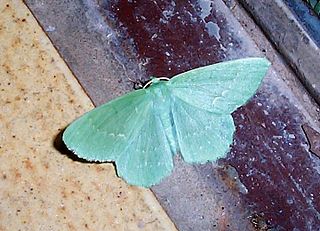
The large emerald is a moth which is the type species for the family Geometridae. It is found throughout the Palearctic region and the Near East in and around deciduous forests, heathlands, marshland and in settlements close to woodland. The species was first described by Carl Linnaeus in his 1758 10th edition of Systema Naturae.

The silver-ground carpet is a moth of the family Geometridae. The species was first described by Michael Denis and Ignaz Schiffermüller in 1775. It is common throughout the Palearctic region including the Near East and North Africa.It is found in a variety of different habitats and occurs, for example, in humid forests, moorland and shore areas, on embankments or on unimproved grass meadows and heathlands as well as in gardens.

The clouded border is a moth of the family Geometridae. The species was first described by Carl Linnaeus in his 1758 10th edition of Systema Naturae. It is distributed across most of Europe to the Urals, western and central Siberia, Transbaikalia, Kazakhstan, Tian-Shan, northern Mongolia and parts of the Near East.

The scalloped oak is a moth of the family Geometridae. The species was first described by Carl Linnaeus in his 1758 10th edition of Systema Naturae.

The mottled umber is a moth of the family Geometridae. It is common throughout much of the Palearctic region. The species was first described by Carl Alexander Clerck in 1759.

The mottled beauty is a moth of the family Geometridae. The species was first described by Carl Linnaeus in his 1758 10th edition of Systema Naturae.

The brimstone moth is a moth of the family Geometridae. The species was first described by Carl Linnaeus in his 1758 10th edition of Systema Naturae. It should not be confused with the brimstone butterfly Gonepteryx rhamni.

The black arches or nun moth is a small Palaearctic moth. It is considered a forest pest.
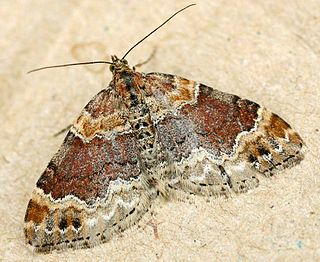
Xanthorhoe spadicearia, the red twin-spot carpet, is a moth of the genus Xanthorhoe in the family Geometridae. The species was first described by Michael Denis and Ignaz Schiffermüller in 1775.

The brindled pug is a moth of the family Geometridae found in Europe including the British Isles as well as further east to the Baltic States, Armenia, Turkey and the Caucasus. South it reaches North Africa.

Biston strataria, the oak beauty, is a moth of the family Geometridae. It is native to Europe, the Balkan countries and the Black Sea region as far as Asia Minor and the Caucasus. The species was first described by Johann Siegfried Hufnagel in 1767. B. strataria is found in a variety of habitats, but is mostly found in woodlands where it rests on the bark of trees, camouflaged by its mottled black and grey wings. The male has feather-like antennae while those of the female are more thread-like. The moth has a wingspan of 40 to 56 mm.
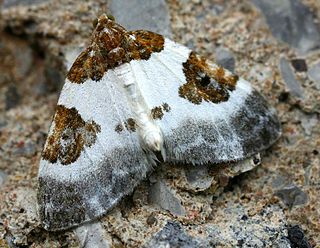
Plemyria rubiginata, the blue-bordered carpet, is a moth of the family Geometridae found in Europe and across the Palearctic. The moth was first described by the Austrian lepidopterists Michael Denis and Ignaz Schiffermüller in 1775.

Plagodis pulveraria, the barred umber, is a moth of the family Geometridae. The species was first described by Carl Linnaeus in his 1758 10th edition of Systema Naturae. It is found throughout much of the Palearctic realm from Ireland to Japan, and in the Nearctic realm (Canada).

Scotopteryx chenopodiata, the shaded broad-bar, is a moth of the family Geometridae. It was first described by Carl Linnaeus in his 1758 10th edition of Systema Naturae.

Selenia lunularia, the lunar thorn, is a moth of the family Geometridae. It is found in Europe except Iberia and Greece; also in Asia Minor, Armenia, SiberiaIssyk-Kul.

Thera obeliscata, the grey pine carpet, is a moth of the family Geometridae. It is found throughout north and central Europe and east across the Palearctic to Siberia, and south to the Caucasus and Transcaucasia. In the Alps it can be found at an altitude of over 1500 metres.

Lycia is a genus of moths in the family Geometridae.

Agriopis aurantiaria, the scarce umber, is a moth of the family Geometridae. It was first described by Jacob Hübner in 1799 and it is found throughout Europe from Spain through Central Europe to Russia. In the south it can be found from the western Mediterranean to the Black Sea and the Caucasus. Its northern distribution reaches as far as central Fennoscandia. The species can be found in many different places, including deciduous forests, orchards, gardens as well as parks and settlement areas.
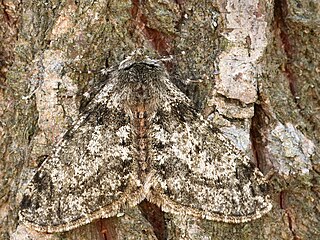
Phigalia pilosaria, the pale brindled beauty, is a moth of the family Geometridae. The species was first described by Michael Denis and Ignaz Schiffermüller in 1775. It is found from Europe and Anatolia to the Caucasus.
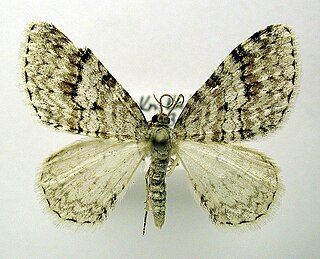
Venusia cambrica, the Welsh wave, is a moth of the family Geometridae. It is found in Europe, western and central Siberia, Altai, Transbaikalia, the Russian Far East, the Korean Peninsula, Japan and in North America, where it can be found across Canada from Newfoundland and Labrador to British Columbia, south in the west to California, south in the east to Georgia.























